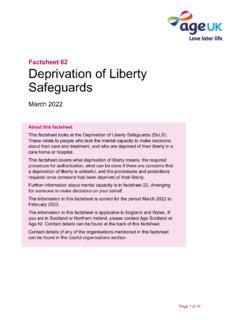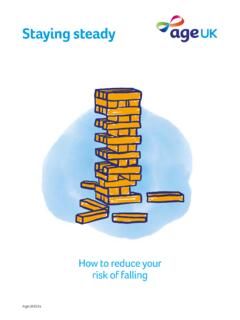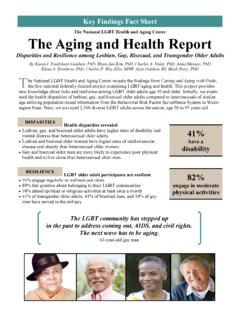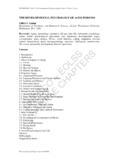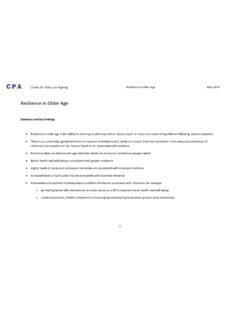Transcription of Improving later life. Vulnerability and resilience in ...
1 Improving later life . Vulnerability and resilience in older people. 1. We are Age UK. Age UK works to improve later life for the 14 million older people in the UK. We do this by addressing health inequality, reducing loneliness and isolation, Improving retirement incomes and tackling poverty and discrimination against those in later life in all its forms. We also speak for the long-term interests of every one of us, so that experiences of ageing grow better for each passing generation. 2. Improving later life . Vulnerability and resilience in older people.
2 Acknowledgements: We wish to thank the following people for help with identifying and inviting authors: Professor Alan Walker, Professor Christine Milligan, Professor Ian Deary, and Professor Martin Knapp. We also thank Anji Mehta from the NIHR School for Social Care Research, and Libby Archer from Age UK's Research Department, for assistance with editing. And not least we thank all of the authors in this book for graciously volunteering their time to write their chapters. Project Managers: Dr Susan Davidson and Phil Rossall. Welcome On behalf of Age UK it's a great pleasure for me to welcome you to this fourth book in our Improving later life ' series.
3 These publications aim to present the latest research findings written by the experts themselves, in an accessible style, to help inform those of us who are older , or who work with or on behalf of older people. Caroline Abrahams The theme of this book is Vulnerability and resilience '. It is based on the Charity Director General, premise that some factors and experiences make us more susceptible to Age UK the risk of adverse outcomes in later life , while others help to buoy us up and protect us. Really, you could argue that the overriding aim of all the services that work with older people ought to be to minimise the former and accentuate the latter this against a context in which it is recognised that older people are an incredibly diverse population.
4 This kind of thinking is very well embedded in work with children and young people, where there has been a lot of policy and research work done around prevention and early intervention in recent years, and it has a great deal to offer older people too. There is a lot of interest at present among policymakers in understanding how to help older people to stay as fit, well and independent as possible for as long as possible, and older people say this matters a great deal to them too. An important part of this is working out what helps and hinders in this respect, and this is where thinking about Vulnerability and resilience needs to come in.
5 For example, thanks to research, we know now in a way we didn't a few years ago that experiencing loneliness in older age has serious potential health impacts. Conversely, there is also now good evidence to show that having good social networks as you age can serve to protect you against various health risks. The implication is clear: an effective health promotion strategy for older people ought to include some focus on helping them to sustain and refresh their friendships. This is an important message for Age UK and it underpins the No one should have no one' campaign that we have recently launched.
6 It is also helping to motivate our growing interest in services that are effective in supporting older people to make new friends and enjoy shared activities, like choirs, dance classes or volunteering. Some people are luckier in life than others, with more of the characteristics and experiences that help protect against adversity and fewer of those that make it more likely. However, it is also true that we can all go through periods when we are especially vulnerable; for example, following bereavement. At times like this we need some extra care and support, so the thinking in this book really isn't about them' it is about all of us' too.
7 4. Key findings What are the key aspects of Vulnerability in later life ? Even if we disregard the role of chance and accident, there is still a wide variation in the extent to which we may become vulnerable and the age at which this process can start, depending on many factors, including: The attitudes held by the individual and by society in general An individual's contact with family and friends The range and availability of support from others The financial resources of the individual The suitability of the home and environment The extent of neighbourhood and local deprivation The individual's education and working history The health behaviour of the individual over the life -course What can be done to help build resilience in later life ?
8 The authors have many suggestions, including specific ones for different issues, but in general we can all: Adopt a holistic view of all kinds of Vulnerability in later life as the main focus rather concentrating on parts of the problem or parts of the body Make better use of the research evidence to identify problems earlier and to target resources Concentrate more on combating the effects of neighbourhood deprivation Work towards providing an age-friendly environment Facilitate home adaptations, aids and a better range of housing options Root out ageism among professionals and society in general 5.
9 Foreword Dr Eileen Burns Too often our elders are depicted as either the hero the old solider, proudly wearing his medals, the land girls with their old photos or the victim, the old lady swindled out of her savings, the old man mugged in the street. Dr Eileen Burns is In my work and in everyday situations, the report I. Consultant Physician, most often hear from older people about how they Medicine for the Elderly feel' is that they feel the same person now as they at St James's Hospital, Leeds. She is also did when they were 21 intrinsically they are that President Elect of the same individual.
10 British Geriatrics Society. The ongoing scientific developments in our understanding of frailty are essential to help health and social care systems understand this reality and to grow the evidence for effective interventions; the recent work of the British Geriatrics Society in conjunction with Age UK and the Royal College of General Practitioners ( Fit for Frailty') is an excellent example of this work. Vulnerability is, however, a much broader issue, encompassing not just those who have physical disability or memory problems (although clearly these can contribute enormously).







